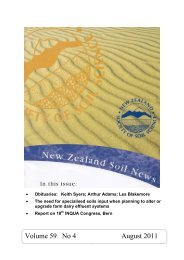Volume 55 No 2 April 2007 - New Zealand Society of Soil Science
Volume 55 No 2 April 2007 - New Zealand Society of Soil Science
Volume 55 No 2 April 2007 - New Zealand Society of Soil Science
You also want an ePaper? Increase the reach of your titles
YUMPU automatically turns print PDFs into web optimized ePapers that Google loves.
on a common parent material could be arranged into development sequences. Taylor named these soil<br />
suites. They were neither mapping units nor classification units, but were a way <strong>of</strong> ordering soils by<br />
stage <strong>of</strong> pr<strong>of</strong>ile development and used to great effect in designing and conducting soil fertility<br />
experiments. The soil report on Whangarei County was never completed although moderately largescale<br />
soil maps were published. However, many concepts were incorporated into later studies and<br />
some soils, for example the ‘egg cup’ podzol became widely known. <strong>Soil</strong> mapping began in Hawke’s<br />
Bay with Harry A. Hughes and others mapping the Heretaunga Plains. This survey was principally to<br />
determine the suitability <strong>of</strong> the soils for orchards. The soils formed on young river alluvium had<br />
differing drainage limitations and there were saline soils on areas <strong>of</strong> the former Ahuriri lagoon, an area<br />
uplifted during the 1931 Napier earthquake. The Heretaunga survey was followed by the survey <strong>of</strong> the<br />
soils <strong>of</strong> mid-Hawke’s Bay by Ivan J. Pohlen, Charles Harris, Harry S. Gibbs and James D. Raeside.<br />
This survey was completed in 1939, but publication was delayed by the war until 1947. This was a<br />
comprehensive land-use survey, used by the Department <strong>of</strong> Agriculture to locate fertilizer trials and in<br />
addition, it identified that soil erosion was a significant problem in mid-Hawke’s Bay.<br />
The war years and a national soil inventory<br />
During the early war years the <strong>Soil</strong> Survey Division undertook a general survey <strong>of</strong> the <strong>No</strong>rth Island’s<br />
soil resources at a map compilation scale <strong>of</strong> four miles to the inch (1:253440). This was a co-operative<br />
project, with the Extension Division <strong>of</strong> the Department <strong>of</strong> Agriculture. The survey rapidly produced<br />
information on the soils <strong>of</strong> unmapped areas. These were linked together with the soil surveys <strong>of</strong> the<br />
previously mapped areas, such as the Waikato, parts <strong>of</strong> <strong>No</strong>rthland, Hawke’s Bay and western<br />
Taranaki. The three survey parties were Dr Grange, C. Harris and Gibbs in Wellington, Pohlen,<br />
Raeside and Gibbs in Hastings, and Taylor, Sutherland and Wright in Whangarei. They started<br />
mapping in February 1940, finished in March 1941 and provisional soil maps were drawn and printed<br />
in 1942.<br />
<strong>Soil</strong>s were mapped as soil sets, defined as “convenient groupings <strong>of</strong> soils with like pr<strong>of</strong>iles or<br />
assemblages <strong>of</strong> pr<strong>of</strong>iles”. A comprehensive inventory <strong>of</strong> soil chemical data formed part <strong>of</strong> the survey<br />
together with summaries <strong>of</strong> relevant agricultural information, from which were produced a series <strong>of</strong><br />
single factor maps. These were used during the war years to plan and set priorities for agriculture and<br />
horticulture production as well as the distribution <strong>of</strong> scarce fertilizers. The army used the soil maps for<br />
logistical planning.<br />
A number <strong>of</strong> other soil surveys were completed during the war years. Gibbs surveyed Matakoa County<br />
on the East Cape <strong>of</strong> <strong>No</strong>rth Island in 1940, and between 1943 and 1945 Westland in the South Island.<br />
From 1943 to 1945 C. Harris surveyed the soils <strong>of</strong> Ellesmere County in Canterbury and between 1943<br />
and 1946 Raeside surveyed the soils <strong>of</strong> Geraldine County. University students who assisted with the<br />
Geraldine survey included John D. McCraw and Douglas S. Coumbs. Ian L. Baumgart joined this<br />
team after leaving the <strong>New</strong> <strong>Zealand</strong> army and completing his university degree. Geraldine County<br />
survey was one <strong>of</strong> several surveys undertaken to identify areas suitable for growing linen flax, a fiber<br />
in short supply during the war, and used in the manufacture <strong>of</strong> fabric skins for military aircraft.<br />
Wright, prior to his enlisting in the army, was involved in Southland conducting other soil surveys for<br />
linen flax production. Gibbs and Birrell were part <strong>of</strong> a team identifying suitable sites for military<br />
airfields throughout <strong>New</strong> <strong>Zealand</strong>.<br />
<strong>Soil</strong> classification and the ordering <strong>of</strong> soil survey information<br />
In the 1940s soil classification was at a formative state in <strong>New</strong> <strong>Zealand</strong>. In the <strong>No</strong>rth Island general<br />
survey, the following categories were used to arrange the soils data: Recent soils, rendzina and<br />
associated podzolic soils, yellow grey loams, primary podzolic soils, secondary podzolic soils, yellow<br />
brown loams, brown granular loams and clays, red brown loams, meadow (or gley) soils, organic soils,<br />
saline soils, and skeletal soils on steep hillsides. Many <strong>of</strong> the categories were ordered into young,<br />
immature, semimature, later semimature, submature and mature stages <strong>of</strong> development. The soils<br />
formed on volcanic ash and sediments derived from volcanic ash, which included the primary podzolic<br />
soils, yellow brown loams and brown granular loams and clays, were grouped into soil suites. These<br />
were named and identified by the soil-forming volcanic ashes previously defined by Grange and<br />
Taylor such as the Taupo, Mairoa and Tirau suites. The skeletal soils included a diverse collection <strong>of</strong><br />
soils on steep hill country that were either unoccupied rangeland, native forests or unsuited to semiintensive<br />
farming at the time.<br />
63










